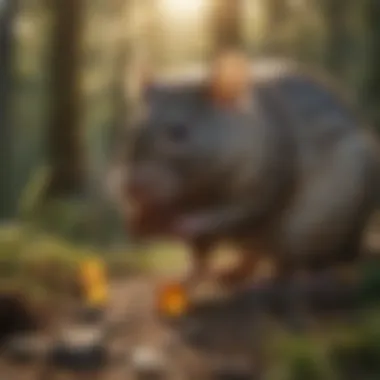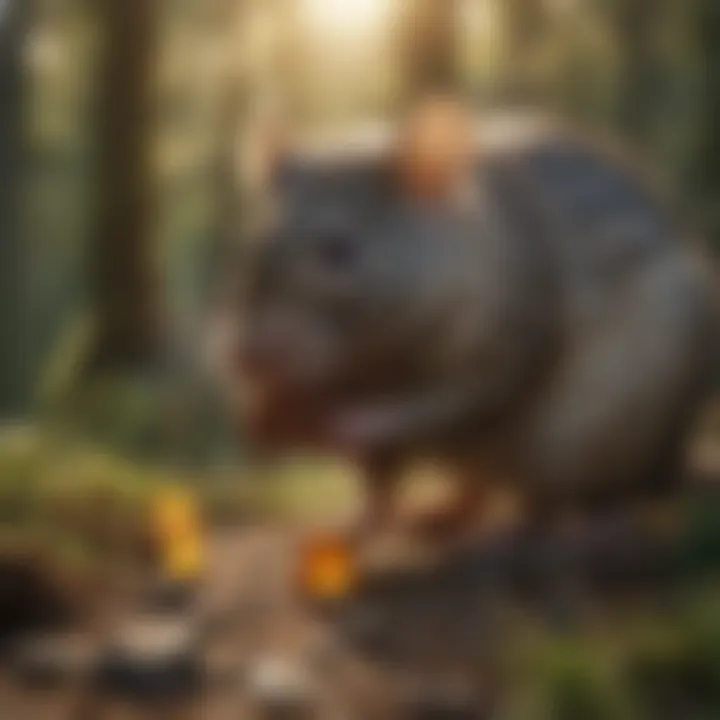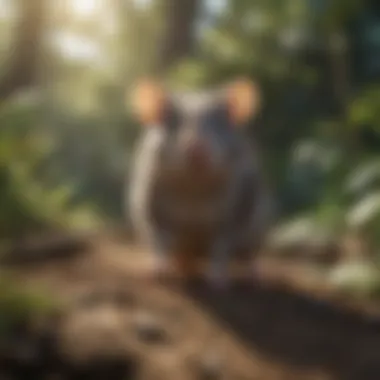The Ecosystem Impact of Bird Friendly Rat Poison


Intro
In a world where urban and suburban environments increasingly clash with nature, the conversation around pest control becomes crucial. Especially notable is the challenge of managing rodent populations while maintaining the health of our bird populations. This article digs into the concept of bird friendly rat poison. It will highlight not only its application in pest control but also its implications for the ecosystem. Understanding this balance is essential for homeowners who wish to protect their property and the wildlife around them.
Understanding Pests
Definition of Pests
Pests are organisms that cause damage to crops, property, and health. They include rodents, insects, and other creatures that can disrupt daily life. In many contexts, “pest” refers to species like rats, mice, and various insects that invade living spaces and gardens. Their presence often leads to significant concern among homeowners.
Importance of Pest Identification
Identifying pests accurately is vital for effective control. Misidentification can lead to ineffective treatment and potential harm to other non-target species. For instance, using traditional rodenticides may unintentionally harm birds or native mammals. Homeowners must understand their specific pest issues to choose solutions that minimize risk to wildlife.
Prevention Techniques
Home and Garden Preventative Measures
Preventing pest infestations starts with basic home and garden practices. Consider the following measures:
- Maintain Cleanliness: Regularly clean up food scraps and debris to minimize attraction for pests.
- Seal Entry Points: Close off any gaps around doors, windows, and vents. Rodents can squeeze through surprisingly small openings.
- Use Secure Storage: Store food in sealed containers and keep pet food secured.
- Proper Waste Management: Ensure trash bins are sealed and emptied regularly.
Seasonal Prevention Tips
As seasons change, so do pest activities. For instance, rodents may seek shelter in colder months. Homeowners should adjust their strategies accordingly. Measures such as trimming overgrown vegetation in the fall can deter rodents from nesting nearby.
Eco-Friendly Pest Control Solutions
Overview of Sustainable Practices
Sustainable pest management strategies focus on minimizing environmental impact while effectively controlling pests. Bird friendly rat poison exemplifies this approach. These products aim to reduce harm to non-target animals while keeping rodent populations in check. Using integrated pest management (IPM) strategies also aligns well with an eco-conscious approach.
Natural Remedies and Their Effectiveness
Natural remedies can serve as alternatives to traditional rodenticides. Homeowners might experiment with components such as:
- Peppermint Oil: This strong scent can repel rodents.
- Cats: Utilizing natural predators like cats can also help control rodent populations.
- Diatomaceous Earth: This substance can deter a variety of pests while being safe for birds and other wildlife.
"Understanding the ecosystem's dynamics is vital. Choices in pest management reflect deeply on wildlife health and biodiversity."
Understanding Traditional Rodenticides
Understanding traditional rodenticides is crucial in the discussion of bird friendly rat poison. This section will provide insights into what rodenticides are, examine their effectiveness and risks, and highlight significant environmental concerns. By grasping these key elements, readers can fully appreciate the need for alternative solutions that prioritize both rodent control and avian preservation.
What Are Rodenticides?
Rodenticides are chemicals specifically designed to eliminate rodents. They can be categorized into two major types: anticoagulants and acute toxins. Anticoagulants, such as brodifacoum and bromadiolone, work by disrupting the body's ability to clot blood, leading to internal bleeding over a period of time. Acute toxins, like zinc phosphide, cause immediate effects, often resulting in death within hours.
While these substances are effective in controlling rodent populations, they also pose significant threats to non-target species. The indiscriminate nature of these poisons often leads to unintended poisoning of wildlife, including birds, mammals, and other creatures that may consume poisoned rats or the bait directly.
Effectiveness and Risks


The effectiveness of traditional rodenticides often depends on various factors, including rodent behavior and environmental conditions. When used correctly, these poisons can significantly reduce rodent numbers in urban and rural settings. However, their effectiveness comes at a steep price. The risks associated with their use extend beyond the primary goal of pest control.
First, the risk of secondary poisoning affects predators, such as birds of prey, that feed on poisoned rodents. These birds may suffer health issues or die due to the toxins accumulated in the prey they consume. Moreover, unregulated use can lead to increased resistance in rodent populations, making them harder to control over time.
Environmental Concerns
The environmental concerns surrounding traditional rodenticides are considerable. They often contribute to ecosystem imbalances. When non-target species, particularly birds, are affected, it can disrupt food webs and lead to declines in bird populations. Reports indicate a troubling trend in raptor and scavenger declines linked to rodenticide exposure.
Furthermore, rodenticides can contaminate soil and waterways. If these chemicals leach into the ground or runoff into nearby streams, they can adversely affect aquatic life and plants. As such, the broader implications of using traditional rodenticides present a compelling case for seeking bird friendly alternatives.
"The long-term health of ecosystems relies on thoughtful pest management strategies that recognize and mitigate risks to non-target wildlife."
In summary, understanding traditional rodenticides is not just about their function but also about their impact. This knowledge serves as a backdrop for advocating bird friendly solutions, which aim to balance effective rodent control with the protection of vulnerable avian populations.
The Necessity of Bird Friendly Solutions
As we grapple with the ecological implications of our pest control methods, the necessity of bird friendly solutions has become increasingly apparent. Traditional rodenticides, while effective in managing pest populations, often lead to collateral damage among non-target species, especially birds. This situation raises concerns and highlights the demand for methods that protect both human interests and avian life. Bird friendly rat poisons emerge as a crucial alternative, offering a balance of effectiveness against rodents while minimizing harm to birds and other wildlife.
Prevalence of Avian Species in Urban Areas
Urban environments have witnessed a notable increase in avian species. Cities like New York and London host diverse bird populations, including pigeons, sparrows, and starlings. These species thrive in urban spaces, benefiting from human activity while contributing to the area's ecological balance. However, the very presence of these birds can lead to increased conflict with rodent control efforts. Bird friendly rat poisons address this coexistence, allowing for rodent management without indiscriminately harming the birds that share our environments.
Impact of Toxicity on Birds
The toxicity of traditional rodenticides is one of the main worries. Birds, being higher up in the food chain, are particularly susceptible to rodenticide poisoning. When poison is ingested by rodents, it can remain in their systems, posing a danger to predators, including birds of prey like hawks and owls. These birds may inadvertently consume poisoned rodents, leading to secondary poisoning that can have lethal consequences. Understanding this impact emphasizes the importance of using bird friendly solutions that mitigate toxicity, ensuring the safety of avian populations while maintaining effective pest control.
Legislative Pressures and Wildlife Protection
In recent years, there has been a significant shift in legislative perspectives regarding pest control methods. Increasing awareness of the ecological impacts of traditional rodenticides has led to stricter regulations aimed at protecting wildlife. Legislation in various regions now focuses on sustainable pest management practices, encouraging the adoption of bird friendly solutions. These pressures not only highlight a growing recognition of avian protection but also necessitate a shift in how homeowners and pest control professionals approach rodent control. It becomes essential to understand these legislative frameworks to comply with laws while effectively managing rodent populations.
Exploring Bird Friendly Rat Poison Options
In the ever-evolving realm of pest control, the exploration of bird friendly rat poison options is crucial. This section aims to shed light on how such alternatives address environmental concerns while effectively managing rodent populations. The necessity for safe and effective solutions is amplified as urban areas witness the increasing presence of avian species. Choosing bird friendly options suggests a commitment to sustainable practices that recognize the interconnectedness of all species in our ecosystem.
Active Ingredients
Understanding the active ingredients in bird friendly rat poison is vital for homeowners and pest control professionals alike. These formulations often utilize natural or less toxic substances, reducing the risk of harm to non-target species, particularly birds. Common active ingredients in these products include:
- Peppermint oil: Known for its deterrent properties, it can repel rodents without posing a significant risk to birds.
- Bromethalin: While still toxic, it is less likely to affect secondary consumers, such as avian species, compared to traditional anticoagulants, making it a better option.
- Cholecalciferol (Vitamin D3): This can cause rodent mortality by elevating calcium levels; its mechanism is less harmful to birds if used correctly.
It's essential to read the product labels carefully to ensure these active ingredients align with environmental objectives. The selection of agents with a reduced toxicity profile reflects a growing awareness of safeguarding wildlife while maintaining pest management effectiveness.
Mechanisms of Action
The mechanisms of action in bird friendly rat poisons differ significantly from traditional rodenticides. These alternatives generally function by disrupting essential biological processes in rodents without greatly affecting birds. Some key mechanisms include:
- Disruption of nerve impulses: Ingredients such as bromethalin interfere with the nervous system of rodents, causing death while posing minimal threat to avian physiology.
- Metabolic interruption: Certain formulations inhibit the rodent’s ability to process calcium, leading to death without the compounding effects seen in more common rodenticides.
The understanding of these mechanisms is fundamental. They allow for informed decisions regarding pest control that meets the needs of urban living while protecting wildlife. Consumers must recognize that although some active ingredients retain toxicity, the broader ecological benefits may outweigh the risks in specific applications.
Efficacy Compared to Traditional Options
When assessing the efficacy of bird friendly rat poisons against traditional rodenticides, it is critical to consider multiple factors. Studies suggest that while traditional options often produce immediate results, their collateral damage to avian populations can result in long-term ecological consequences. Comparative points include:


- Mortality rates among target species: While traditional rodenticides are designed for maximum lethality, bird friendly options aim for a balance that effectively reduces rodent populations without significant harm to birds.
- Persistence in the environment: Traditional rodenticides may remain in habitats, continuing to pose risks to wildlife. In contrast, many bird friendly options break down more quickly, thereby reducing potential ecological risks.
- Public perception and acceptance: Increasing awareness about wildlife conservation encourages homeowners to seek safer solutions. Bird friendly options often resonate better with environmentally-conscious consumers.
Choosing to use bird friendly rat poisons presents a complex yet rewarding challenge for pest management. By understanding the active ingredients, mechanisms of action, and effectiveness compared to traditional options, consumers can make informed decisions that align pest control with wildlife preservation.
Best Practices for Using Bird Friendly Rat Poison
Using bird friendly rat poison effectively requires adherence to specific best practices. These practices are crucial not only for achieving your pest control goals but also for protecting the surrounding ecosystem, particularly avian species. This section dives into key strategies that can enhance the safety and efficacy of pest management efforts while minimizing adverse environmental impacts.
Application Techniques
When applying bird friendly rat poison, it is vital to follow recommended application techniques. These contibute to both effectiveness and safety. Here are some critical considerations:
- Read the Labels: Always start by reading the manufacturer's instructions carefully. This ensures that you understand the specific dosage and method of application for the product you are using.
- Use Protective Equipment: Wear gloves and a mask to protect yourself during the application process. Safety should never be compromised, even with products designed with birds in mind.
- Bait Preparation: Prepare the bait in a way that minimizes exposure to non-target species. For example, consider using enclosed bait stations that only allow access to rodents while keeping birds and other animals away.
- Timing Matters: Apply the bait during periods when rodent activity is high, which can avoid unnecessary applications and reduce potential risks to birds during their feeding times.
- Monitor Results: After application, continuously monitor the area to assess the effectiveness of the bait and check for any signs of non-target species interactions.
Placement Strategies
Placement of bird friendly rat poison is equally important. Effective strategies can help ensure that the poison targets only the intended pests while safeguarding other wildlife:
- Strategic Locations: Place bait stations near areas where you have observed rodent activity, such as burrows, pathways, or nesting sites. Avoid placing them in open areas where birds might easily come into contact with the bait.
- Height Considerations: Elevate bait stations if possible. Many bird species forage at specific heights and keeping bait out of their reach can significantly reduce unintended exposure.
- Concealment: Camouflage bait stations with natural materials. This makes them less noticeable to birds while still accessible to rodents.
- Regular Check-Ups: Inspect the bait stations regularly. Replace bait that has been consumed or has degraded. Keeping an eye on these stations helps prevent stale bait from remaining in the environment longer than necessary.
"Using bird friendly rat poison responsibly requires understanding the nuances of application and placement that center on ecological harmony."
- Community Involvement: Encourage neighbors to adopt similar practices. A community-wide approach maximizes the effectiveness of pest control while fostering a safer environment for birds and other wildlife.
By implementing these best practices, homeowners and pest control professionals can pursue effective rodent management while maintaining a commitment to wildlife protection. This balance is essential for creating a sustainable coexistence between human needs and avian populations.
Case Studies of Bird Friendly Rat Poison Implementation
Understanding real-world applications of bird friendly rat poison is vital. Case studies highlight the practical effects of these products, the methods used, and the lessons learned. These examples provide insights into how different environments can successfully implement such alternatives. This section will focus on urban and agricultural settings to show diverse impacts, adaptations, and results observed in various circumstances.
Urban Environments
In urban settings, the challenge lies in the density of human population combined with the presence of wildlife. Many cities have implemented bird friendly rat poisons, responding to concerns of non-target species, especially birds. Cities such as San Francisco have seen successful reductions in rodent populations while safeguarding local avian life. The use of these products has proven effective in reducing rodent numbers without causing collateral harm to wildlife.
Key points to consider regarding urban implementations include:
- Selection of Active Ingredients: Bird friendly options often use natural agents like sodium bicarbonate instead of traditional anticoagulants. This minimizes risk to birds.
- Community Involvement: Education and awareness campaigns encourage residents to adopt safer pest control strategies. Residents need to know the vital role they play in ensuring both rodent control and avian safety.
- Monitoring Success: Cities often carry out environmental impact assessments to track the success of bird friendly poisons. These studies show changes in rodent populations as well as bird survival rates.
The success stories from urban areas can serve as a model for others facing similar challenges in pest management. These cases prove that it is possible to implement effective solutions that benefit both humans and wildlife.
Agricultural Settings
Agricultural environments present unique challenges and opportunities for bird friendly rat poisons. Farmers need effective rodent control to protect their crops, but they also recognize the importance of preserving local wildlife populations. In regions like California’s Central Valley, farmers have begun using bird friendly rat poisons as part of integrated pest management strategies.
Considering agricultural applications, the following factors are essential:
- Impact on Non-Target Species: Using lower toxicity levels and non-lethal methods ensures that key species, such as barn owls, can thrive and contribute to natural pest control.
- Ecosystem Implications: There is a growing understanding of avoiding impacts on the food web within farm ecosystems. Using bird friendly products can support a more balanced approach, promoting biodiversity.
- Economic Considerations: Farmers have reported lower costs in the long term due to better pest management practices that do not require constant reapplication of toxic substances.
"Adopting bird friendly rat poison in agriculture has not only helped protect our crops but also enriched the ecosystem. We see more birds returning, which is a win-win situation for all of us."
The success in agricultural implementations shows that cooperation between pest control solutions and ecological health is achievable. These case studies help to reinforce the need for environmentally sound practices in both urban and agricultural realms.
Potential Challenges in Adoption


The concept of bird friendly rat poison presents several challenges. These challenges must be understood and addressed for effective implementation in pest control. The adoption of such solutions not only helps protect avian species but also ensures balanced ecosystems. However, various factors can hinder this transition.
Public Awareness and Education
Public awareness is crucial in effectively adopting bird friendly rat poison practices. Most homeowners may be unaware of the dangers posed by traditional rodenticides, not just to birds but also to other wildlife. Education campaigns can help demystify the need for safer alternatives. For example, community workshops or information sessions can highlight how bird friendly options work. People often rely on convenience and brand familiarity when choosing pest control products. This means they may not consider eco-friendly alternatives unless informed.
Additionally, materials should be clear and accessible. For instance, infographics or simple brochures that outline the benefits and correct usage of these alternatives could be effective. Engaging local community leaders or environmental groups can further spread awareness. Building a network of advocates may lead to a more informed public and increased willingness to adopt new practices.
Regulatory Hurdles
Regulatory hurdles also play a significant role in the adoption of bird friendly rat poison. These products must undergo rigorous testing and approval processes. Many potential bird friendly options may face delays in getting approval due to existing regulations governing pest control substances. Manufacturers often struggle to navigate these regulations, leading to fewer options in the market.
It is essential to collaborate with regulatory bodies to review existing laws. Advocating for updated legislation that accommodates innovative pest control methods can pave the way for broader acceptance. Simplifying the approval process can make the introduction of new products easier and faster. Stakeholders, including both industry experts and environmental advocates, should push for the creation of guidelines that hasten the introduction of effective, bird friendly solutions.
If innovation is to flourish in pest control, smoother regulations are essential.
In summary, both public awareness and regulatory challenges must be addressed. Education is vital for informing homeowners about the benefits of bird friendly approaches. Likewise, collaboration with officials can ease product adoption. Overcoming these hurdles can significantly enhance the effectiveness of environmentally sound pest control efforts.
Future Directions in Pest Control
The evolving landscape of pest control necessitates a reevaluation of methods used to address rodent issues while safeguarding avian populations. The focus must shift towards strategies that not only control pests effectively but also ensure minimal harm to non-target species. Innovations in technology and shifts towards more ecological practices are paramount. This dual approach provides a path forward that harmonizes human needs with environmental sustainability.
Technological Innovations
Innovative technologies in pest management hold the potential to revolutionize limitations associated with traditional methods. Advances in smart traps, for instance, provide effective efficiency in rodent control. These traps can be monitored remotely, giving homeowners the ability to manage pest issues with real-time data. Such innovations can reduce the reliance on chemical rodenticides, which pose risks to wildlife.
Additionally, integrated pest management (IPM) systems utilize a combination of biological, physical, and chemical controls. This holistic approach enhances decision-making based on environmental assessments. Utilizing software that analyzes pest populations helps in tailoring solutions specific to the location and seasonality of pests. This method not only optimizes resource allocation but also minimizes unintended consequences on birds and other wildlife.
Another innovation includes the use of non-lethal repellents. A variety of natural compounds that are unappealing to rodents can deter infestations without the risk of secondary poisoning to avian species.
Integrating Ecological Practices
Incorporating ecological practices into pest management strategies is vital for long-term sustainability. This could involve promoting biodiversity within urban and residential areas. Planting native vegetation serves as a natural deterrent for pest populations while also attracting beneficial insects and birds. This creates a balanced ecosystem which works collaboratively to control pest species.
Additionally, habitat management is key in reducing rodent attractants. Keeping areas clean, sealing entry points in buildings, and ensuring proper waste management significantly decrease the likelihood of infestations. These practices decrease the necessity for rodenticides while fostering an ecosystem that supports avian health.
Moreover, education plays an essential role in the adoption of these ecologically sound methods. Homeowners need resources and knowledge to make informed decisions about pest control. Workshops and community programs led by pest management professionals can be invaluable in guiding individuals and families towards bird-friendly practices.
"The future of pest control relies heavily on a comprehensive understanding of ecological dynamics and the responsible application of technology."
Finale and Recommendations
The discussion on bird friendly rat poison is crucial, not just for the pest control industry but for overall ecosystem health. As humanity continues to expand into wildlife habitats, the interaction between rodent control and avian safety becomes increasingly significant. Bird friendly solutions offer benefits that extend beyond simply controlling rodent populations. They help maintain a balanced ecosystem where both rodents and birds can coexist without undue harm.
Summarizing Key Insights
In this article, we have explored several key insights regarding bird friendly rat poison:
- Environmental Safety: Traditional rodenticides pose significant risks to non-target species, especially birds. Bird friendly alternatives minimize these risks, thereby protecting vulnerable avian populations.
- Efficacy: Bird friendly rat poisons have been proven effective in controlling rodent populations without negatively impacting the ecosystem.
- Legislative Impact: As governments impose stricter regulations on harmful poisons, the shift toward more sustainable pest control methods becomes imperative.
- Public Awareness: Educating the public about the dangers of traditional rodenticides may encourage the adoption of bird friendly options.
This comprehensive view highlights the importance of utilizing bird friendly rat poisons to mitigate risks to wildlife while achieving pest control objectives.
Call for Collaboration
To truly make a difference in pest management strategies, collaboration among stakeholders is essential. Homeowners, pest control professionals, environmentalists, and lawmakers must work together to promote safer alternatives.
- Homeowner Education: Homeowners should be informed about the dangers associated with traditional poisons. This outreach can foster a mindset shift toward safer alternatives.
- Pest Control Industry: Professionals in the pest control industry must adapt their practices to include bird friendly solutions. This means investing in education, training, and resources.
- Legislative Support: Laws encouraging the use of safer products must be backed by scientific research to ensure that both effectiveness and ecological responsibility are maintained.
By working together, these groups can create a proactive path toward sustainable pest control, protecting not just birds but the entire ecosystem.

